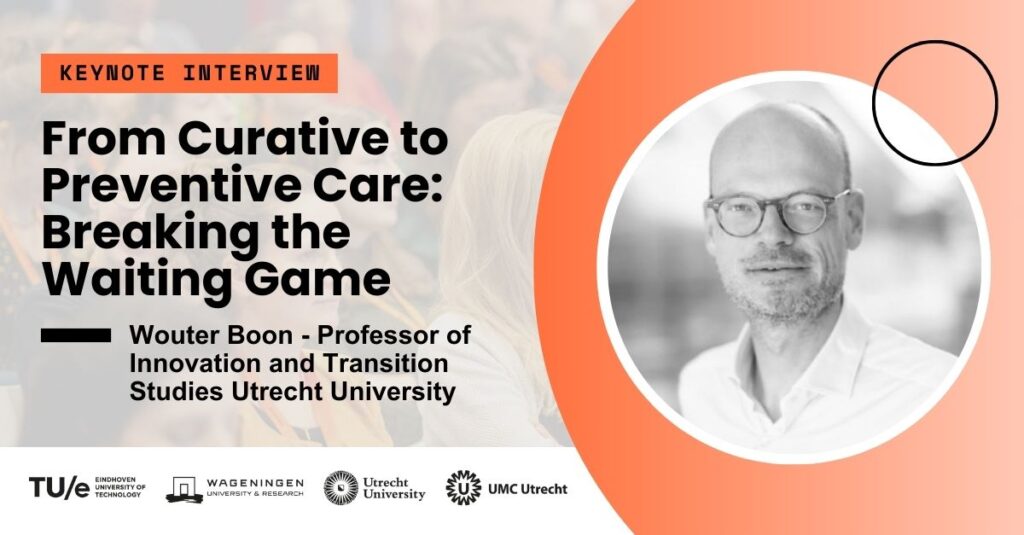There is no shortage of pilot projects, but without embedding them in the healthcare system, scaling up remains challenging, argues transition expert Wouter Boon. This hampers the shift from curative to preventive care. During the annual conference of the institute for Preventive Health, he delves into this transition process and the fundamental changes needed to accelerate it, such as new forms of financing and changes in legislation and regulations.

“We are in the first transition phase from curative to preventive care, which involves experimenting in protected learning environments,” says Wouter Boon, Professor of Innovation and Transition at Utrecht University. “There are numerous prevention pilot projects, such as in the Utrecht neighbourhood of Cartesius, where health centres and gyms collaborate to promote a healthy lifestyle among residents. However, we have not yet succeeded in embedding these pilots in the healthcare system. The current system only accommodates the provision and use of healthcare services focused on treatment. This hinders the scaling up of prevention projects, and thus the transition to the next phase, ‘acceleration.”
From Business Model to Proven Strategy
One of the biggest barriers, according to Boon, is the business model of prevention: “The benefits often do not reach those who bear the costs. For instance, if the Ministry of Health, Welfare, and Sport invests in prevention, it is likely that the Ministry of Social Affairs and Employment will benefit through reduced sick leave payments. Or consider the annual changes in health insurers: the ‘old’ insurer invests, while the ‘new’ one reaps the rewards.”
”One of the biggest barriers is the business model of prevention: the benefits often do not reach those who bear the costs.”
“Additionally, we observe high expectations in the innovation domain regarding digital technological tools, such as health apps. Health insurers typically only reimburse these apps if they have proven effectiveness, but gathering evidence costs money. Studies require users, but people will only use the app if it works and is reimbursed. In short, there is a waiting game at play. Someone needs to take the first step to break this cycle.”
Boon states, “What doesn’t help is that medical studies are heavily focused on treatment. Prevention is integrated into various specialties, such as general practice and geriatric care, but it is never the main focus. Additionally, less research funding is allocated to prevention, and it seems to carry less prestige among students and professionals.”
Fundamental Changes
“To move from the experimentation phase to the acceleration phase, we need to provide more space for experiments, which means investing,” Boon continues. “Consider governments, health insurers, or medical organisations financing innovative care approaches. Or think about creating tolerance policies and free play areas, such as regulatory sandboxes, where you can build and dismantle metaphorical sandcastles to gain experience and gather evidence. Many experiments, after all, still do not fit within existing regulations. Additionally, it is important to think early in the experimentation process about what will be needed for scaling up, such as gathering evidence for a functioning app.”
“To move from the experimentation phase to the acceleration phase, we need to provide more space for experiments, which means investing”
“We need to have discussions about these fundamental changes now: what changes are necessary and how can we facilitate them? After all, you cannot expect individual pioneers to keep experimenting endlessly at their own expense and without any prospects.”
“Additionally, preventive care must continue to legitimise itself and consider how it can become both cool and commonplace, just like wearing a seatbelt or having a light on your bike. This requires a different narrative, as we still associate prevention too much with patronising messages about ‘musts,’ such as quitting smoking and drinking less, or exercising more.”
Socio-Technical Transitions
Finally, Boon emphasises the importance of not overlooking the social aspect of transitions: “As you build a new system, you dismantle an old one. This always creates winners and losers. Producers of cookies, crisps, and soft drinks may need to look for alternative (healthier) products. Certain medical specialists may receive less funding, while prevention may receive more. It is crucial to involve everyone in the transition and to think about new roles for those who might be disadvantaged. Otherwise, a new type of resistance will emerge, slowing down the process. Transitions are always socio-technical. Without a solid embedding in society, technological innovations, such as apps, will have little effect.”